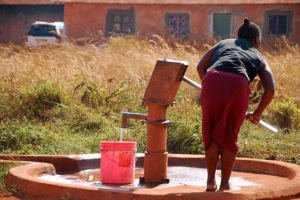While many people in the U.S. take water for granted, those in developing countries are not as fortunate. In fact, more than 350 million people in Africa alone suffer daily from the effects of water scarcity. To help end the water crisis in Africa, many organizations have made it their mission to provide access to safe, clean, and reliable water. This can be accomplished by digging water wells within communities. With access to clean water, families across Africa can enjoy a better quality of life without fear of health implications caused by unsanitary water sources.

Traditional Hand-Dug Wells
With its diverse geology, building water wells in Africa can be a challenging endeavor. To help meet the needs of African communities, there are several different types of wells dug. Unfortunately, not all are made equal.
The most basic type of well used in parts of Africa are hand dug wells. These wells typically span 50 or more feet deep and work best when there is an abundance of ground water. However, there are certain consequences that come with building and using traditional hand-dug wells.
First, these wells can be highly dangerous to build, especially for unskilled workers. Due to the level of danger involved, the building of hand-dug wells can lead to severe injury and death. In addition, hand-dug wells are prone to contamination. As the wells are often left uncovered, debris can fall into the well making it unsafe to drink.
When hand-dug wells are not the most advantageous well option, it is the only solution in some areas of Africa. When installed properly, these wells can be extremely effective.
Low-Cost Shallow Wells
With the donation of small rigs, digging water wells has been made easier and safer. These portable machines can be used to dig wells up to 200 feet deep. Once the desired depth has been achieved, a casing is installed to protect the well from debris and to prevent collapse.
A temporary pump is then placed over the well to help monitor water output and quality. If the well is found to meet regulations, it is mounted onto a concrete slab and completed with a positive displacement hand pump. These newer wells remain completely sealed to ensure that the water remains clean and safe to drink without treatment.
Once the well is completed, the village committee is provided with training on how to use and maintain the well. Through this training they are given valuable information about each mechanical component of the pump and how to locate and repair problems if they should occur.
Committees are also often provided training in proper sanitation and hygiene practices. As illnesses are often transmitted through water in many parts of Africa, it is important to share information on how to prevent the spread of disease and infection.
Wells in Developed Countries
Wells in highly developed countries like the U.S. undergo the well building process a little differently. Every state in the U.S. has specific regulations on where wells can be located to prevent problems such as pollution and contaminants.
Drilled wells are the most modern option and are constructed by rotary-drilling or percussion machines which are able to drill thousands of feet deep. These wells require a casing which helps maintain the well opening and keep excess water and dirt out. Drilled wells have a relatively low risk of contamination due to their depth and use of resilient casing.
Wells in the U.S. are typically installed by bonded, insured, and licensed professionals to ensure accuracy. Many drillers and well pump installers receive national training certifications in addition to meeting state requirements.
Building Wells in Africa
Unclean water is a major threat to millions of men, women, and children throughout Africa, especially in Liberia and rural regions. Sadly, children are most affected by water scarcity and unsanitary water conditions in these areas. An estimated 2.2 million children die each year from diarrhea and other water-related illnesses that are highly preventable.
Most illnesses, deaths, and hardships in Africa can be minimized or eliminated by providing families with access to clean safe water. This is where well building comes into play. Building wells is a cost-effective way to help countless communities gain access to fresh water that can be safely used for drinking and bathing. The cost of building a well can vary significantly depending on where the well is being built, the size of the well, and the technology used for construction. However, the average cost per well for The Last Well is $3,000 and serves an average of 600 Liberians.
The Last Well is on a mission to provide the entire nation of Liberia with access to safe drinking water by 2020 and offer the gospel. For more information about this cause or to see how you can get involved, contact The Last Well today.







